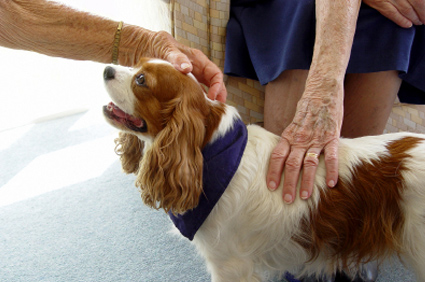Pet therapy, or animal-assisted therapy, is a wonderful opportunity for you to share your pet with people. Dogs that are registered therapy animals visit schools, hospitals, prisons, libraries, nursing homes, and any other facility where interactions with pets help people. Pet therapy activities vary widely - from simply having a dog sit in the room with a patient to more “hands on” interactions including petting, brushing, walking, playing fetch, doing tricks or something - and all of these have been shown to help people take their mind off their own problems.
Animals can reach people in a special way because they can make people feel safe and loved unconditionally. Despite the fact that animals don’t use words, the human-animal bond is powerful and children or patients who are afraid feel braver and stronger when they are around a pet. Studies show that patients in hospitals that are visited by pets have lower blood pressure, heart rates and stress levels. Even though cats, birds, horses, rabbits and other small animals make wonderful therapists, I want to focus this post on dogs and what characteristics make them good therapy candidates.
There are some general characteristics to consider when you are trying to determine if your dog is cut out for therapy work. Therapy dogs are most successful when they enjoy interactions with people, allow strangers to pet them, can walk on a leash without pulling, can remain calm around distractions, listen to their handler and are comfortable with children and medical equipment like wheelchairs, oxygen tanks, canes or walkers. They also need to be comfortable with rough handling and jerky movements, as children and sick people may not be able to be gentle. Dogs that are brave, like to nudge your hand for attention or put their head in your lap usually are amazing therapy workers.
Generally speaking, most programs require that your dog must be above one year of age, have proof of rabies vaccination or titers and proof of a current fecal exam that is negative for infectious organisms. To become a registered therapy animal, your dog must usually undergo a temperament evaluation to make sure his or her personality is a good fit for the program. Even though the requirements vary with the program, the certification process also usually involves two or three observed visits to see how your dog does when faced with strange sights and smells.
I am familiar with several national not-for-profit programs that certify dogs for pet therapy: Therapy Dogs International (www.tdi-dog.org), Therapy Dogs, Inc. (www.therapydogs.com) or Delta Society Pet Partners (www.deltasociety.org). You can look online to see if these organizations have a local chapter in your area. When you register with one of these associations, you and your dog are protected by liability insurance when you visit, so it is a really good idea to become certified pet therapy partners. Your dog does not have to be purebred to be certified, but usually for liability purposes, wolves or wolf hybrids cannot be certified.
A therapy dog is only half of the team. You, as the handler, are just as important in the equation, and it is a good idea to ask yourself if you would make a good therapy partner for your dog. Most pet therapy associations require a minimum number of visits per year, to follow their rules and regulations, carry a membership card and vaccine records when visiting and take your dog in to see your family veterinarian yearly for a physical and a fecal exam. Many therapy animal organizations offer benefits, including primary accident and liability insurance and, in some cases scholarships, but bringing the smile to the face of a sick child or providing comfort and affection to the elderly is a unique and unforgettable benefit you’ll get nowhere else.
So what is your experience with pet-assisted therapy? I would love to hear your story, so chime in and leave a comment on this blog if you have one to share.
Thank you so much for all you do to make the world a better place for companion animals.

Dr. Jane Bicks








 RSS Feed
RSS Feed




